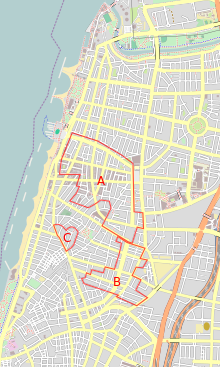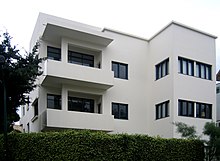White City (Tel Aviv)
| White City of Tel Aviv | |
|---|---|
|
UNESCO world heritage |
|

|
|
| Zina Dizengoff Square |
|
| National territory: |
|
| Type: | Culture |
| Criteria : | ii, iv |
| Surface: | 140 ha |
| Reference No .: | 1096 |
| UNESCO region : | Europe and North America |
| History of enrollment | |
| Enrollment: | 2003 (session 27) |
As the White City ( Hebrew העיר הלבנה ha-ʿir ha-lewana ) is a collection of over 4,000 buildings in Tel Aviv , most of which were built in the Bauhaus and International styles . The architects of these buildings were for the most part Jews of German descent who had emigrated from Germany after the " seizure of power " by the National Socialists in 1933 . The White City of Tel Aviv has been a UNESCO World Heritage Site since 2003 .
history
When the White City came into being, Tel Aviv, founded in 1909, was a little more than 20 year old settlement of Jewish immigrants at the gates of Jaffa . Meir Dizengoff , Mayor of Tel Aviv from 1921 to 1936, commissioned the Scottish city planner Patrick Geddes to draft a master plan for the rapidly growing city in 1925 . Geddes designed the street network and the layout of blocks of houses and the use of space; a particular architectural style was not determined by him. In the 1930s, however, it was mainly Jewish architects who had received their training at the Bauhaus Dessau who began to make their mark on the new district. After 1933, but especially after the Reich Citizenship Law came into force in 1935, it became increasingly difficult for Jews in Germany to work in numerous professions. Jewish architects were therefore forced to leave Germany. Many of them then settled in what was then the British Mandate of Palestine .
The Bauhaus buildings in Tel Aviv are adapted to the hot climate of Israel. Many rely on pillar constructions ( pilotis ) to improve ventilation. Instead of window fronts, light strips were used. The Israeli architects replaced Le Corbusier's long windows with ribbon-like balconies with aprons providing shade. The flat roofs are used as a place to stay on hot summer nights.
Over time, many buildings in the White City have been clearly neglected, some have been demolished or changed. The plaster of the once white buildings in particular has turned gray over the years and due to the influence of the sea breeze.
To protect the architectural heritage, around a thousand buildings were listed as historical monuments in 2009. The rents for apartments in Bauhaus buildings are high, a three-room apartment is said to cost $ 4,000 a month.
Tel Aviv Bauhaus architects
- Shlomo amber
- Munio Gitai wine robbery
- Edgar Hed (pike)
- Shmuel Mestechkin
- Chanan Frenkel
- Arieh Sharon
- Philip Huett
Bauhaus Center
The Bauhaus Center in Tel Aviv, which opened in 2000, deals with the recording and documentation of the White City and its popularization.
Bauhaus museum
A small Bauhaus museum was opened in 2008 on Bialik Street, near the Old Town Hall. It was designed by the Israeli designer and architect Ron Arad .
White City Center
For the 100th birthday of the Bauhaus, the White City Center , center for monument protection and architecture, opened in Tel Aviv . Germany supported the project in the period from 2014 to 2025 with a total of three million euros in order to preserve the German-Jewish heritage on the Mediterranean. The museum is located in the Liebling House in the center of the city and opened on September 19, 2019.
gallery
Printer of the daily newspaper Haaretz
literature
- Stefan Boness, Tel Aviv - The White City , Jovis-Verlag, Berlin 2012, ISBN 978-3-939633-75-4
- White City Tel Aviv: On the Preservation of Modern Buildings in Israel and Germany. (PDF) Federal Office for Building and Regional Planning , Bonn 2015, ISBN 978-3-87994-158-2
Web links
- Entry on the UNESCO World Heritage Center website ( English and French ).
- Official website of the White City (English)
- Videos and photos about the architecture in Tel Aviv in the SWR archive "Treasures of the World"
- Departmental research project White City Tel Aviv BBSR
- Speaking contemporary witness - White City Center in Tel Aviv Article dated December 2nd, 2019 about the opening of the White City Center, the information center about the White City
Individual evidence
- ↑ UNESCO World Heritage Site whc.unesco.org; Retrieved October 13, 2013
- ^ Bauhaus stroll in Tel Aviv: The dream city. In: Spiegel online. Retrieved September 20, 2019 .
- ↑ The battle for the white city . In: FAZ , May 8, 2013, p. 7
- ↑ Sharon Udasin: Bauhaus Is Our House . ( Memento from January 16, 2016 in the Internet Archive ) The Jewish Week , May 22, 2009
- ↑ Living in Tel Aviv: Only the sun shines for everyone. In: Frankfurter Allgemeine Zeitung. Retrieved September 20, 2019 .
- ^ Bauhaus Center Tel Aviv. Retrieved September 20, 2019 .
- ↑ bauhaus-center.com
- ^ Esther Hecht: Bauhaus Museum Opens in Tel Aviv's White City . In: Architectural Record . Retrieved September 5, 2012.
- ^ David Bachar: Surroundings / Daniella Luxembourg's Bauhaus kiosk . Haaretz, 1 May 2008
- ↑ German-Israeli project in Tel Aviv honors international style. In: Israelnetz .de. September 18, 2019, accessed October 1, 2019 .
Coordinates: 32 ° 4 ′ 40 ″ N , 34 ° 46 ′ 26 ″ E









